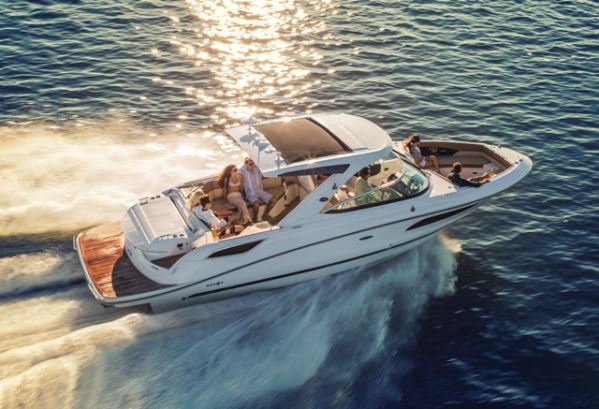 Once upon a time the relationship between pontoon boats and deck boats was large and very distinct. But in the last decade or so the differences are definitely getting smaller. Originally pontoons were the awkward, slower but cheaper distant cousin of deck boats. Offering enough deck space to host a small cocktail party was really their only redeeming quality. Deck boats, in contrast, were the flashy, more expensive, more powerful boat with a little less comfort and seating capacity than a pontoon.
Once upon a time the relationship between pontoon boats and deck boats was large and very distinct. But in the last decade or so the differences are definitely getting smaller. Originally pontoons were the awkward, slower but cheaper distant cousin of deck boats. Offering enough deck space to host a small cocktail party was really their only redeeming quality. Deck boats, in contrast, were the flashy, more expensive, more powerful boat with a little less comfort and seating capacity than a pontoon.
Much has changed. With the addition of performance-enhancing features such as three-logged pontoons, lifting strakes and higher horsepower ratings, pontoons now can rival or even exceed the performance of some deck boats. Deck boats, in addition, have improved to the point where they can equal seating capacity and creature comforts typical of some pontoons.
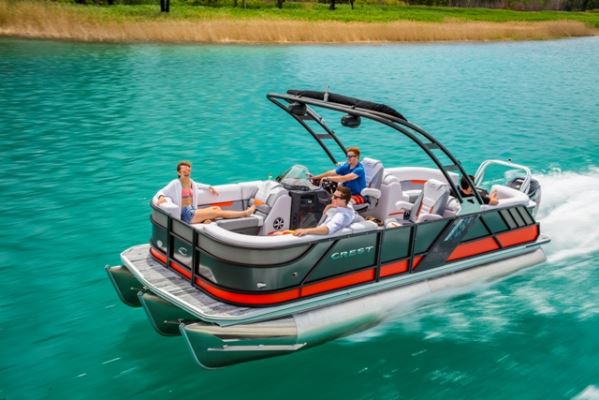 The Physique
The Physique
While some of the typical differences between pontoons and deck boats are blurring, there are still distinct physical features that continue to make pontoons and deck boats unique.
Deck boats have sleek aerodynamic lines similar to other sport boats and have great aesthetic appeal. Compared to their classy cousin, pontoons tend to be more boxy and less nautical looking, although that’s becoming less and less true each year as new pontoon models and the use of fiberglass layouts are being released.
The Hull Truth
The main physical difference between a pontoon and a deck boat is the shape and function of the hull. Deck boats typically have a V-shaped hull, while pontoons typically lie flat on the water with the deck balanced on two or three aluminum tubes.
.jpg_600.jpg) The V-shaped hull on deck boats enables the boat to cut through the water and get up on plane at a high speed, creating a surfable wake. A V-shaped hull boat is most fuel efficient when cruising at high speeds since slower speeds infringe on the hull’s natural ability to rise and slice through the water. On the down side, since a V-shaped hull boat pivots on a central axis, this can cause the craft to gracelessly rock to the movement of passengers or turbulent wind and waves. But with a wide enough V-hull, the issue of stability is generally nullified.
The V-shaped hull on deck boats enables the boat to cut through the water and get up on plane at a high speed, creating a surfable wake. A V-shaped hull boat is most fuel efficient when cruising at high speeds since slower speeds infringe on the hull’s natural ability to rise and slice through the water. On the down side, since a V-shaped hull boat pivots on a central axis, this can cause the craft to gracelessly rock to the movement of passengers or turbulent wind and waves. But with a wide enough V-hull, the issue of stability is generally nullified.
However, a pontoon’s flat deck and hull lend great stability on the smooth water which easily resists the side-to-side roll typical of deck boats. It is this stability that makes pontoons such great spaces for entertaining. That being said, pontoons were designed for sheltered waters such as lakes and rivers, but have become a possible option for those using Intracoastal waterways. Pontoons are more fuel efficient at slower speeds since the flat hull cruises on top of the water rather than cutting through it like a V-hull boat. As such, pontoons require more power and fuel to reach the same speeds as a deck boat and without the surfable wake.
.jpg_600.jpg) Take A Seat
Take A Seat
There is a reason pontoons are known as floating living rooms. Among day boats, pontoons offer the more usable space for the dollar than any other boat, including deck boats. Pontoons can typically fit anywhere from 10 to 20 people depending on the model. Deck boats, while not as spacious as pontoons, can still easily accommodate 8 to 12 people, which really is not too shabby for such a multi-purpose boat.
Performance
In the past, a 40 to 90 horsepower outboard was typical of pontoons. Not anymore. Long gone are the pontoons that barely eclipse 20 mph on a good day. Most pontoons currently on the lot are equipped with a 115 to 200hp engine and more and can easily cruise anywhere from 40 to 60 mph or more on the water. Although we’ve seen triple-digit speeds from pontoons recently, that kind of speed is far from typical, although it is amazing how light and powerful the new outboards are getting.
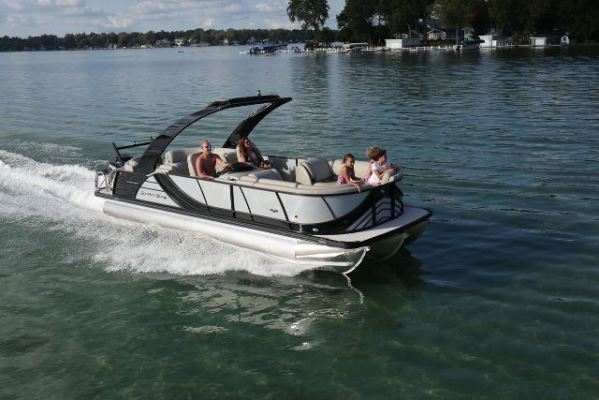 But speed is not everything. Pontoons in general still tend to be limited in regard to maneuverability by comparison. But pontoon manufacturers have gone to great lengths to rectify this situation with the advent of three-logged pontoons with lifting strakes and performance packages. Three tubes instead of two give performance pontoons similar handling and control as a V-hull boat. The addition of a 25-inch diameter centerline tube with a 20-inch lifting pad aft enables pontoons to make zippy starts and sharp turns, which skiers and tubers normally don’t experience on typical pontoons. Also, adding inner lifting strakes to the outside tubes helps the pontoon cut through the water by creating lift.
But speed is not everything. Pontoons in general still tend to be limited in regard to maneuverability by comparison. But pontoon manufacturers have gone to great lengths to rectify this situation with the advent of three-logged pontoons with lifting strakes and performance packages. Three tubes instead of two give performance pontoons similar handling and control as a V-hull boat. The addition of a 25-inch diameter centerline tube with a 20-inch lifting pad aft enables pontoons to make zippy starts and sharp turns, which skiers and tubers normally don’t experience on typical pontoons. Also, adding inner lifting strakes to the outside tubes helps the pontoon cut through the water by creating lift.
While three-pontoon models may close the performance gap between pontoons and deck boats, most pontoons still can’t compare to the agility and speedy features of deck boats. Deck boats are similar to ski boats and bow riders in their ability to make sharp turns and cut through the water at high speeds. But alas, because of deck boats’ extra deck space and with the added weight of a full load, balance and speed may at times be compromised.
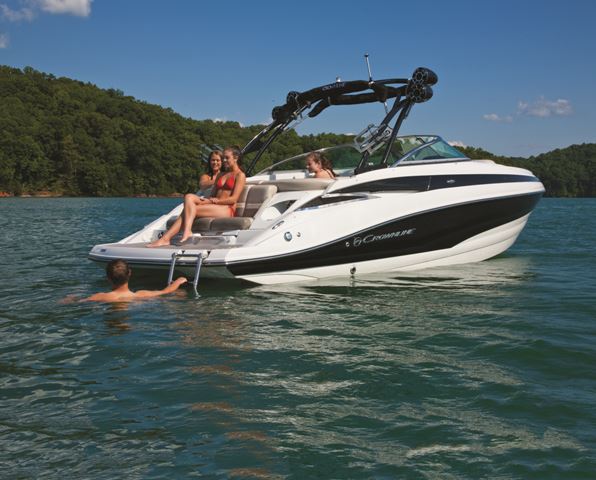 Also worth noting, it is normal for deck boats to have inboard engines or 300hp outboards and be able to reach speeds from 50 to 70 mph.
Also worth noting, it is normal for deck boats to have inboard engines or 300hp outboards and be able to reach speeds from 50 to 70 mph.
Entertainment
The physical differences between deck boats and pontoons lend them to different types of entertainment. Depending on entertainment preferences such as watersports, fishing or just hanging out, one of the two types of watercrafts will be a better match for your needs.
Watersports
Pontoons with a nice 150hp engine can easily tow amateur tubers in their wake, but pontoons may not have enough pep for more advanced skiers who want a little more air as they ride the surf.
If a fast and rolling ride is a must for your boat, a deck boat with a 300hp engine, along with the maneuverability created by a V-shape hull, will easily fill your need for speed. For tow watersports, the deck boat has a slight advantage over the pontoon, but that gap is quickly closing—especially on the sport pontoons that now offer full wakeboard towers or arches.
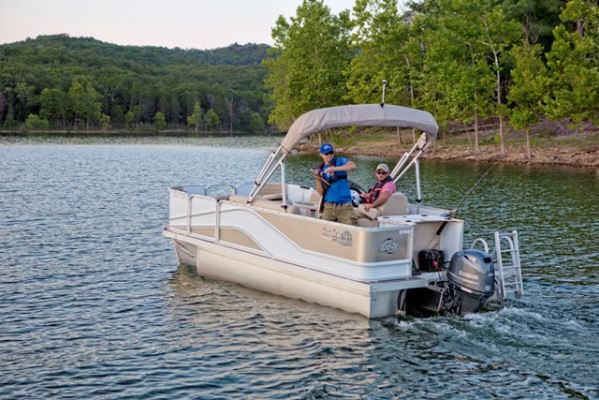 Fishing
Fishing
While deck boats are more than capable of helping you reel in the catch of the day, with pontoons, the shallow draft makes it easy to get to those honey holes. Plus the stable platform and extra room to move around are two other advantages that give pontoons the edge.
Good Company
Since pontoons are literally floating, fenced patios, if your idea of spending a day on the lake includes a barbecue, wine, music, lounging in the sun or beaching on a sand bar, a pontoon would be a perfect fit for you. Pontoons are great spaces for parties and for low-key family outings.
Deck boats are roomy in their own right, but they don’t lend themselves as easily to being a floating party like pontoons do. If your idea of fun is towing family and friends on tubes, kneeboards or skis, either a pontoon or a deck boat would be a good fit for augmenting your time on the lake.
.JPG_600.jpg) Bang For Buck
Bang For Buck
Typically it is cheaper to acquire a decent pontoon than a deck boat. However, keep in mind that with pontoon and deck boats, the engine can be up to a third of the total price of the boat.
A pontoon may cost $30K, but after buying an engine and a few options the total price could equal $50K or more. That being said, you can expect to pay anywhere from $80K to $100K (or even more) for a fully-equipped pontoon with maximum horsepower.
The starting price for a decent deck boat starts at around the $30K mark to upward of $80K. But as with anything, you can spend as much as you want on a boat and you do get what you pay for as far as quality, craftsmanship and amenities. But whatever craft you choose, there has never been a better time to get out on the water and start enjoying the benefits and advantages of owning either a pontoon or a deck boat than there is today.

